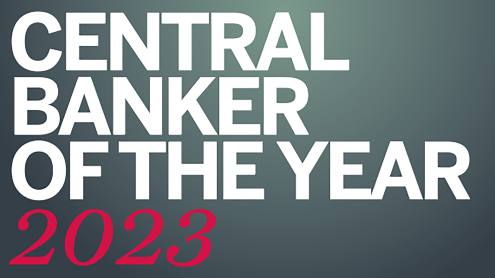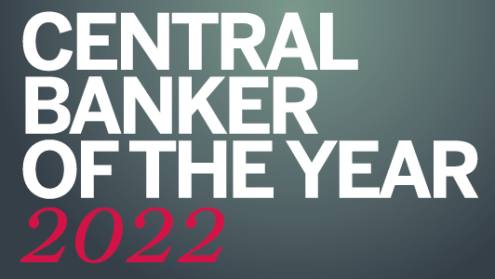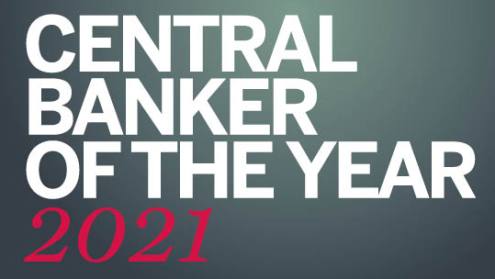Global and Europe
Boris Vujcic, Croatia
Boris Vujcic is no stranger to multitasking. For seven years until Croatia’s accession in 2013, he was deputy chief negotiator in the country’s successful bid to join the EU. During this period, he was also deputy governor of the Croatian National Bank, then governor from 2012. These days he combines running the central bank with designing Croatia’s strategy to join the eurozone, as well as chairing the steering committee of the Vienna Initiative.
Little known outside the region, the Vienna Initiative began in 2009 at the height of the global financial crisis as a means for ensuring the financial stability of emerging economies in central and eastern Europe. The fear was that large western and northern European banks, which dominated their financial systems, would withdraw loans and spark a devastating credit crunch. The Vienna Initiative has since grown to 17 regional countries, together with international financial institutions, the European Commission and several large European commercial lenders.
As of March 2018, non-performing loans (NPLs) for the 17 countries had gone down to Ä38.3bn, or 4.2% of total loans, levels “where we don’t see them any more as a serious threat”, says Mr Vujcic. With the Croatian central bank governor at the helm, the Vienna Initiative has now broadened its remit to discussing issues such as financing innovation. This is important to the region as the ‘catch-up’ growth model, based on access to the EU market and abundant low-wage, skilled labour, shows signs of running out of steam.
Croatia has benefited hugely from EU membership. “Exports have been the main driver of growth. Once we joined the EU, our goods exports started to boom, by 10 percentage points every year,” says Mr Vujcic.
In May 2018, the International Monetary Fund noted “record high tourism activity, solid merchandise exports and strong domestic consumption”, and praised “continued fiscal overperformance” in Croatia that resulted in the first general government surplus in 2017 since independence.
One blackspot is NPLs, down only 7 percentage points from their peak ratio of 17% of gross loans. “We expected them to be significantly below 10% by now but in 2017 we had the crisis of Agrokor, the largest corporate in not just Croatia but the whole Balkans. That stopped the decline in NPLs, but it was just a short-term halt,” says Mr Vujcic.
The level of debt at the agricultural conglomerate was “incredible,” he says. “As a central bank we saw there was a risk, and for five years we told many of our banks that they could not lend any more to Agrokor. We also prevented excessive lending to companies very dependent on Agrokor… So, when Agrokor eventually went down, our domestic banks were safe. However, the company went to the international market and raised a lot of finance there, mainly from Russian banks.”
Mr Vujcic has been outspoken about the need for immigration to counter Croatia’s declining population. “There will be an employee deficit that will increase in the future, that is very clear.” The government has responded by increasing the retirement age. He also advocates “education to overcome structural mismatches in the labour market, where tomorrow’s jobs will be different to the skills we are currently providing to young people”. Work processes can also be digitised and automated to substitute for labour. All these measures, however, will not be enough “if we do not also import labour. Immigration, in my view, is an absolute necessity,” says Mr Vujcic.
Adopting the euro should prove less politically controversial. Croatia is already the “most highly euro-ised economy outside of the Eurozone,” adds Mr Vujcic. “Approximately three-quarters of all term and savings deposits in the Croatian banking system are in euros, and approximately two-thirds of all debt of all sectors – households, companies and government – is in euros.” Total euro-linked debt in Croatia amounts to about 150% of gross domestic product.
In practice, this means that the exchange rate for the kuna cannot be used as a tool to boost competitiveness. “Depreciation in our case is pro-recessionary, not expansionary,” says Mr Vujcic. “It’s like in the Bob Dylan song, ‘When you ain’t got nothing, you got nothing to lose’.”
Central Banker of the Year, Americas
Alejandro Diaz de Leon, Mexico
Mexico’s central bank governor, Alejandro Díaz de León, has had his work cut out for him. When he took the helm of Banco de México in December 2017, after having previously served as its deputy governor, trouble was stirring.
Rising interest rates in the US were spurring investors to rethink their emerging markets exposures; the future of the North American free-trade agreement – on which the Mexican economy relies on – was uncertain; and Mexico was entering an election year that could have placed a potentially market-unfriendly president in charge.
Throughout such volatile times, Mr Díaz de León ensured markets could anticipate monetary policy decisions. Banco de México’s strategy has been to foster “an orderly adjustment of the Mexican economy to the different external and internal challenges that we have faced”, he says.
Prompt and clear communication is vital to the success of stronger corrective actions to control inflation, and to improve transparency and accountability the central bank has introduced additional measures. From February 2018, it began releasing inflation forecasts, both for consumer price index and core inflation, for the eight quarters ahead.
These serve not only as an indication of the future trajectory envisaged by the bank, but also as a reference to better communicate the size and implications of potential future shocks once threats emerge, and how monetary policy might adjust to them. Full transcripts of monetary committee discussions will be available three years after they take place, earlier than in some other markets; statements and minutes will simultaneously be available in Spanish and English; and all board member speeches will be available online.
Central banks’ actions can help keep economies on a healthy path, but some of the global and national challenges that countries face are beyond monetary institutions’ remit. The Bank of Mexico governor believes that despite the social frustration that current conditions in Mexico and elsewhere have caused, “we need to avoid quick fixes or mirages, and double down on the right set of policies and maintain strong fundamentals”.
These, he says, include keeping economies open to trade and capital flows; embracing technological change; a resilient financial sector; improving social mobility; and promoting strong institutions. “In this regard, an autonomous central bank with the objective of providing stability as a public good is essential,” he adds.
It is in recognition of Mr Díaz de León’s wise leadership, The Banker has named him Central Bank Governor of the Year for the Americas.
Central Banker of the Year, Asia-Pacific
Nor Shamsiah Mohd Yunus, Malaysia
Nor Shamsiah Mohd Yunus, Malaysia’s central bank governor, only came to office in July 2018 but since then, has undertaken a raft of reforms with the aim of boosting gross domestic product (GDP) and tackling poverty.
Ms Nor Shamsiah came into the central bank after being integral to the 1MDB investigations that shook Malaysia in 2017. With this background she has been urging greater transparency in banking, and is seen as being a solid choice in pushing for stronger regulations and accountability in the country’s banking system.
To fight black market cash payments, she has reduced the threshold for transactions that must be reported to the central bank: deposits of RM25,000 ($5970) and above will have to be explained from January 2019 – half the amount that has to be reported under existing laws. The country is also taking steps to reduce money laundering, as it has some of the highest rates in the world. Senior officials are now also required to show greater levels of accountability in the operation of their businesses.
Ms Nor Shamsiah’s policies have the population’s needs in mind. Foreign insurers operating in Malaysia must comply with stricter rules, in an attempt to give better healthcare to the whole population and are now required to contribute to the National Health Protection Fund, which provides aid to the poorest 40% of households in the country. (If they do not they will have to divest their stake.) From January 2019, Malaysia will also provide coverage against critical illnesses and hospital care for its most vulnerable citizens.
The country’s growth has attracted international recognition, with the World Bank reporting Malaysia is showing signs of becoming a high-growth country. This prediction is backed by Ms Nor Shamsiah, who forecasts the country will register GDP growth of 4.8% for the full-year 2018, and 4.9% in 2019.
Looking to the future, Ms Nor Shamsiah plans to strengthen the country’s use of technology, recognising that it can be implemented for a range of services. Tying in to her plans on strengthening the country’s regulatory landscape, the move towards digital payments is hoped to reduce the dependence on cash and tackle financial crime.
Central Banker of the Year, Middle East
Mohammad Y Al-Hashel, Kuwait
Mohammad Y Al-Hashel, the winner of the 2019 Middle East Central Bank Governor of the Year award, has emerged as a regional rising star.
Since taking the helm of the Central Bank of Kuwait in 2012 at the age of 37, Mr Al-Hashel has steered the country’s financial sector through the turbulence of the post-financial crisis period into calmer waters. In doing so, he has nurtured one of the strongest banking sectors anywhere in the world. Today, Kuwaiti banks are well capitalised, profitable and boast excellent asset quality. This favourable position owes much to the work of Mr Al-Hashel and the central bank through their efforts to stabilise the wider financial system.
Under Mr Al-Hashel’s guidance, the central bank has improved the country’s capital adequacy regime. By early 2018, Kuwaiti banks enjoyed a capital adequacy ratio of about 18.3%. Additional capital requirements have been placed on systemically important banks, while other measures – including the introduction of a simple leverage ratio to ensure banks do not become over-leveraged – exceed global benchmarks.
As noted by the International Monetary Fund (IMF), each of these regulatory requirements are carefully weighted by the central bank in terms of costs and benefits, and are periodically reassessed to ensure resilience is developed in an efficient way.
Beyond regulation, Mr Al-Hashel has become a leading advocate for the growth of Islamic finance in Kuwait and around the world. This has seen the Central Bank of Kuwait partner with a number of international organisations, including the IMF and the Islamic Financial Services Board, to host events and seminars to promote the growth of sharia-compliant financial products and services on a global scale. Today, about 40% of Kuwait’s banking sector assets are sharia-compliant, pointing to the growth of the country as a hub for Islamic finance.
Meanwhile, in November 2018, the central bank launched Kuwait’s first fintech regulatory sandbox. The rationale behind the sandbox is to offer fintech entities a safe environment in which to test products and services linked to electronic payment activities.
The sandbox functions over a four-stage process in which applications are made and reviewed by the central bank, followed by a technical security and supervisory assessment.
Central Banker of the Year, Africa
Abdellatif Jouahri, Morocco
Morocco’s economic trajectory continues to exhibit strong, underlying fundamentals, even as the country grapples with a number of developmental challenges.
The impact of a severe drought dented economic growth in 2016, which came in at just 1.2%. But improving weather conditions ameliorated the overall outlook for the country in 2017 when gross domestic product expanded by 4.4%. Figures from the central bank, Bank Al Maghrib, expect growth to reach about 3.5% in 2018 before dipping slightly to 3.1% in 2019.
Under these conditions, the country’s banking sector has also been strengthened, largely as a result of work by the central bank and its governor, Abdellatif Jouahri. Though Moroccan banks registered modest Tier 1 capital and capital adequacy ratios of about 9.4% and 12%, respectively, midway through 2018, other indicators remain strong. The sector’s liquidity coverage ratio stood at 152% by the end of 2017, while problem loans were at 7.5% midway through 2018, falling for the first time since 2010 according to rating agency Moody’s. Encouragingly, the agency expects these problem loans to fall further in the coming years.
Meanwhile, the central bank has been working towards currency liberalisation by abandoning its nominal exchange rate (pegged to the euro, at 60% of the basket, and US dollar, at 40%) in pursuit of an inflation-targeting regime. This is expected to take a number of years.
In an important step in this exercise, the central bank loosened the currency fluctuations around the peg to 2.5% each way in January 2018. This gradual process of currency liberalisation should improve the competitiveness of the economy and promote higher levels of investment and diversification of trade flows with Africa, according to Moody’s.
In a testament to Mr Jouahri’s steady hand at the helm of the central bank, inflation has remained consistently low in recent times. Over the past decade it has averaged just 1.5%. Policy rates in Morocco have been maintained at 2.25% since March 2016.
In addition, the central bank has partnered with the national telecommunications regulator to jointly launched a national mobile wallet at the end of 2018; mobile wallet payments in Morocco are expected to hit $5.3bn by 2023.






